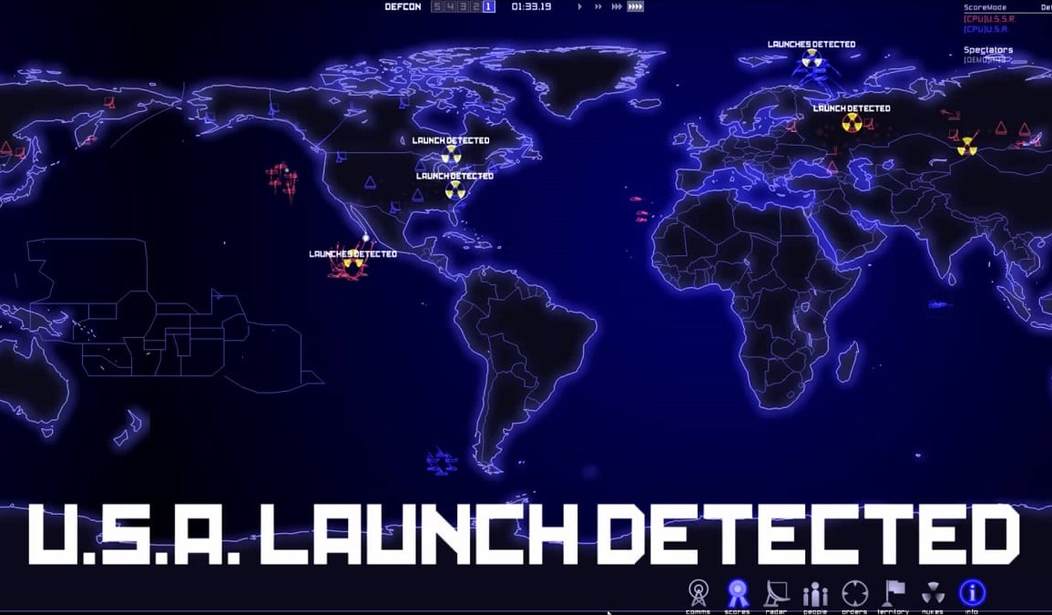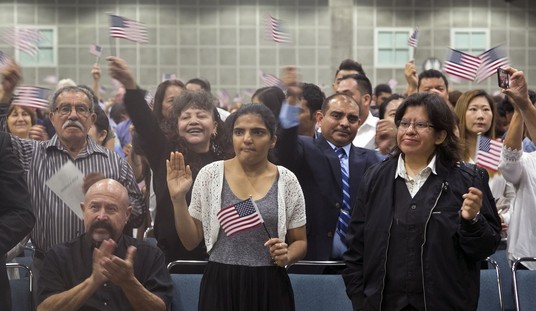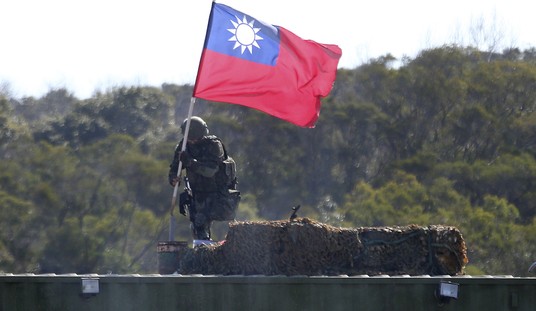So yesterday Donald Trump sent a tweet to the effect that he was in favor of expanding our nuclear weapons capability. This was in response to Putin announcing that he intended to produce sufficient nukes that Russia could overpower any missile defense system by sheer brute force. He followed that up with an MSNBC appearance:
Trump had alarmed non-proliferation experts on Thursday with a Twitter post that said the United States “must greatly strengthen and expand its nuclear capability until such time as the world comes to its senses regarding nukes.”
MSNBC’s Mika Brzezinski spoke with Trump on the phone and asked him to expand on his tweet. She said he responded: “Let it be an arms race. We will outmatch them at every pass and outlast them all.”
The objections to this rather simple statement of fact (Russia has a smaller GDP than California and its population is crashing) are that this is unprecedented, that no US president would voluntarily engage in an arms race, and that Trump shouldn’t be making policy via Twitter, and that a president elect should shut up.
That latter proposition has some merit but ever since Barack Obama created the “Office of the President Elect” and began to make policy statements in 2008, that horse is rather out of the barn. I’d rather go back to the old days where the president elect stayed in seclusion but those were days before Barack Obama set about trying to lock in his successor’s policy options, for instance, the “permanent” moratorium on deep water drilling. You can disagree with the style but in doing so you are putting your personal preference forward as the way things should be done.
I am open to being convinced that transmitting policy by Twitter isn’t the greatest thing but, in the case of the Russian nuclear gambit and the Obama administration’s pettiness in dealing with Israel, his tweets got results (though by the latest news, less than one might have hoped in Israel). And that counts.
But as to the actual critique of Trump’s statement, it is hard to criticize it from a viewpoint of it being an unprecedented act. Quite the opposite. If bears a similarity to Reagan’s position on nuclear weapons and an arms race though it is nowhere near as edge. What was Reagan’s position on an arms race? (A quick break here. I am not comparing Trump to Reagan and the threat faced by the US by the USSR and that we face from Russia are not even in the same ballpark. But unprecedented implies without precedent.)

In fact, Reagan threw off the whole strategy of Mutual Assured Destruction and embraced the idea that the United States could fight and win a nuclear war with the USSR. During the 1980 campaign, George H. W. Bush was asked about this subject:
“You have a survivability of command and control, survivability of industrial potential, protection of a percentage of your citizens, and you have the capability that inflicts more damage on the opposition than it can inflict upon you. That’s the way you can have a winner….”
Shortly after becoming president, Reagan made this statement: “Yes, there could be a limited nuclear war in Europe.”
Perhaps the most famous quote comes from Undersecretary of Defense Thomas K. Jones who opined:
“The United States could recover form an all-out nuclear war with the Soviet Union in just two to four years…Nuclear war is not nearly as devastating as we have been led to believe. If there are enough shovels to go around, everybody’s going to make it. Dig a hole in the ground, cover with with a couple of doors, and then cover the doors with three feet of dirt. It’s the dirt that does it.”
Once in office Reagan began a massive program of nuclear rearmament. This from the Arms Control Association:
Soon after taking office, and under pressure from NATO allies, the administration resumed talks to limit intermediate-range nuclear forces based in Europe, a process that had begun under Carter. At the outset of these negotiations, the United States proposed the elimination of all U.S. and Soviet intermediate-range (1,000-5,500 kilometers) nuclear weapons on a global basis, the so-called zero-option, which the Soviets rejected. The two sides would gradually move closer to an INF agreement over the next six years.
Reagan’s first nuclear initiative, however, went in the opposite direction. In October 1981, he unveiled his plan for a major, strategic modernization program to add thousands of additional warheads and a variety of new delivery systems to the U.S. arsenal, while improving U.S. command and control capabilities. The strategic package, which in large part built on previous programs, called for a big increase in bomber forces, including 100 B-lBs and the development of stealth bombers, a new land-based 10-warhead strategic missile (the MX), and new intermediate-range missile deployments in Europe. In addition, he proposed deploying more than 3,000 air-launched cruise missiles on bombers. Reagan called for accelerated development and deployment of the Trident II D-5 submarine-launched ballistic missile and sea-launched cruise missiles.
The MX missile was among the most technically and politically controversial programs of the first years of the administration. The MX was more precise and more powerful but was considered by many to be a destabilizing first-strike weapon. Due to strong bipartisan opposition, the original plan to shuttle MX missiles on an extensive rail network in the western United States was scrapped. In November 1982, after considering more than 30 basing plans, the Reagan administration proposed deployment of 100 MX missiles in fixed silos.
The nuclear buildup also led to increased activity at more than a dozen major aging and unsafe nuclear-weapon production plants and called for continued nuclear testing. Under Reagan’s watch, spending on nuclear weapons research, development, testing, and production totaled $39.5 billion (in constant 1996 dollars), a 39 percent increase over the previous eight-year period.[1] The cost of environmental remediation at these sites now exceeds $6 billion annually.
The aims of the U.S. strategic buildup were twofold: to reduce U.S. vulnerability by expanding the number and diversity of nuclear weapons and to increase Soviet vulnerability so that the United States could acquire the capability to fight and win an extended nuclear war. The prospect of an arms race seemed less frightening to Reagan, who said in 1978 that “the Soviet Union cannot possibly match us in an arms race,” than to his predecessors. Continued Soviet missile programs and a skyrocketing U.S. budget deficit, however, called into question the validity of this judgment.
The proposed buildup was based on the controversial notion that U.S. nuclear superiority would provide greater military and political leverage vis-à-vis the Soviets. The Pentagon’s 1984-88 Defense Guidance document, which was leaked to reporters in 1982, stated that, in the event of nuclear war, “[t]he United States must prevail and be able to force the Soviet Union to seek earliest termination of hostilities on terms favorable to the United States.” To many observers, this statement appeared to reflect a belief that nuclear war could be won, a view that Reagan and his top aides had attributed to Soviet leaders. In public statements, Reagan denied he held this view and said, “Everybody would be a loser if there’s a nuclear war.”
To say that the left went utterly crazy is an understatement. (By the way, I voted for Reagan twice, I was a commissioned officer during the totality of his administration, please don’t tell me about what Reagan did unless you lived through his administration). A television movie “event” called The Day After, which dealt with the aftermath of a nuclear exchange with the USSR, made having the vapors fashionable again and was actually made required viewing in some schools. NPR carried stories of children who couldn’t sleep because of their fear of nuclear war. The Nuclear Freeze movement sprang from the Kremlin’s checkbook, hired Ted Kennedy and Pete Seeger as front men, and demonstrated incessantly against the deployment of a specific class of nuclear weapons, specifically the Ground Launched Cruise Missile (GLCM) and the Pershing II theater nuclear missile. These were weapons that negated the Soviet conventional superiority in Europe and for which the USSR had no answer.
If you look at a chart of US nuclear warheads over time, I’m providing a blow up for the willfully obtuse,

you see that there is a three year decline in the number of US nukes due to SALT II and then Reagan adds about 1,000 weapons to the US arsenal from 1982-1985. There is a slight reduction after 1985 due to the retirement of some systems. You will note that the fruit of Reagan’s nuclear reduction treaty was not felt until after the USSR was on the way out and Reagan was out of office.
There are two points here. First, a president, or even a candidate, announcing what the policy of his government will be is right and proper. Reagan announced in 1980 that he was fine with an arms race because we would win. Trump did the same today if MSNBC is correct. And they were both right though, in fairness, Reagan’s assessment went against the economic forecasts the CIA was producing for the USSR right up until the last months of its existence. In fact, Reagan’s initial position was that the United States must prepare to fight and win a protracted thermonuclear exchange with the USSR. This concept was far outside the accepted norms of defense policy since the beginning of the Cold War. The degree to which he was serious is unknown and unknowable but that uncertainty also shaped thought within the Kremlin because it effectively destroyed their existing planning for war with the West.
Second, an arms race is not the best use of national treasure but if declaring your intent is to never be outgunned by your enemies makes them aware of the stakes it isn’t bad. What brought Gorbachev to terms was the obvious fact that Reagan’s defense build up, including his improvements in the quantity and quality of nuclear weapons, was eroding the advantage the USSR held in the late 70s and, as Gorbachev knew, the USSR/Warsaw Pact could not match the US/NATO dollar for dollar in defense spending, either conventional or nuclear.
What is illustrative is that Reagan did set out to immediately do what he had said he was going to do on the campaign trail.
I don’t have a problem in the least with Trump’s reaction to Putin. And one would think that the people who have been alleging Trump is Putin’s puppet would at least have the intellectual honesty to admit that this declaration was in reaction to Putin and shows pretty clearly that Trump doesn’t intend to let the Russians achieve any kind of military advantage. Because if he hadn’t reacted this way you know exactly what those same critics would be saying.














Join the conversation as a VIP Member